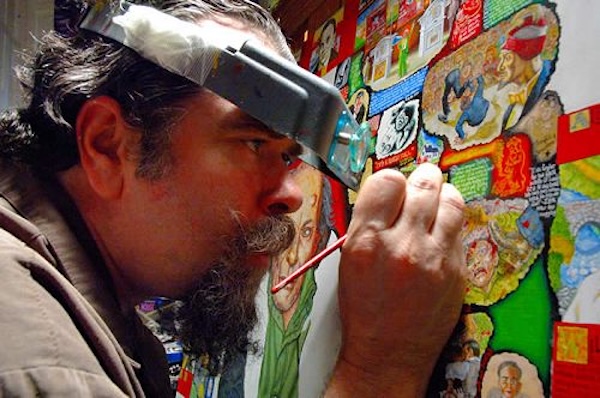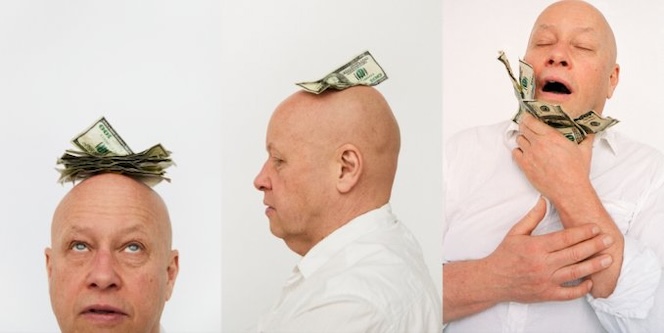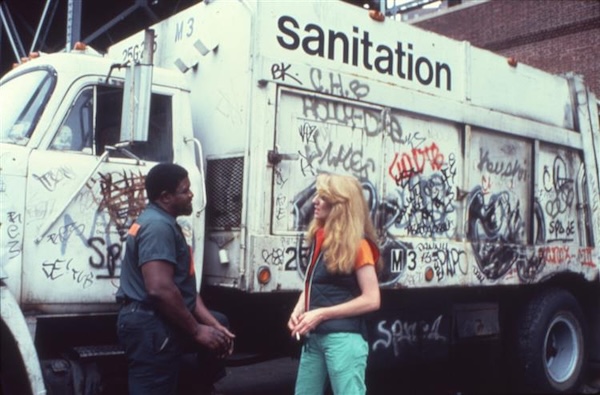Film Reviews: Movies on Art at the 2025 Tribeca Film Festival
By David D’Arcy
“Art is anything you can get away with,” said Marshall McLuhan. Three films that premiered at the Tribeca Film Festival suggest that he was right.

A scene featuring Joe Coleman in Scott Gracheff’s How Dark My Love. Photo: Tribeca
How Dark My Love is the ominous title of Scott Gracheff’s documentary about Joe Coleman, who paints large, wildly detailed, and unapologetically grotesque portraits. The 60-ish Coleman has been working for years and has gotten the attention of those with a taste for the comics-inspired and the carnivalesque. The artist’s goal — beyond creating ambitious paintings filled with multiple stories and characters — is to break into the mainstream art world. That’s a challenge since, as Coleman insists in the film, his paintings “all speak about … what is life and what is death … the shit that most people want to shy away from. It’s hard to think about. It should be hard to think about.”
The film, which won Tribeca’s documentary audience award, brings you close to Coleman, a tactile guy who paints wearing a pair of jeweler’s magnifying glasses and spends years on each individual painting. He paints faces so they feel inescapably close, and he surrounds them with scenes that might go on for pages of panels, as if he were creating comics. (The influence of Robert Crumb and underground comics is all over his work.) And, taking the tactility of Coleman’s art to an extra dimension, his wife Whitney Ward, a photographer, is also a professional dominatrix and discipline therapist whose work is, well, hands-on. The film watches Coleman as he paints a nearly seven-foot portrait of Whitney, a four-year project for which he can’t find a buyer.
Another influence on Coleman seems to be Pre-Code Hollywood melodrama. Faces often have a frenzied expression and gaze at the camera head-on. Think of a canvas with a crazed face at its center, surrounded with scenes from the life of the subject. Think of Renaissance painting; think of a Weegee photograph of a criminal with a rigid stare.
Coleman may not be part of a single movement, but he has company among contemporary artists who paint the grotesque — Crumb colleague S. Clay Wilson, Peter Saul, Jim Nutt, at times Louise Bourgeois, and even Cindy Sherman at her dark moments. Curator Robert Storr, not seen in the film, has been a champion of a grotesque school that he calls “retinal hysteria,” but Coleman’s key admirer in the doc is Jeffrey Deitch, a dealer with a nose for the odd and transgressively marketable. Deitch showed Coleman in a Neo-grotesque show co-organized with the mega-dealer Larry Gagosian in Miami a few years ago. So far, the work hasn’t taken off in the market.
We’ll see soon enough if an award from Tribeca’s audience can expand Coleman’s niche following. As with most films on artists, Gracheff’s camera rarely stays on a picture long enough to show you all that’s there, and this is work that you don’t rush past. Coleman has a new self-published book for those, like me, who want more.

A scene from Ole Juncker’s Take the Money and Run. Photo: Tribeca
Take the Money and Run, a documentary from Denmark directed by Ole Juncker, is about an artist determined to outwit the art market.
Never mind that the film’s title is the same as the 1969 Woody Allen comedy. Titles are not protected under US copyright law. Maybe Juncker thought that some of Allen’s neurotic appeal, still strong in Europe, might rub off. And, if you’re wondering, the documentary’s protagonist, a Danish artist, did take the money.
And so begins the doc’s investigation. Jens Haaning is an artist who can be described as a rebel satirist. His works of art are often performances that tend toward the conceptual. A Danish museum, the Kunsten Museum of Modern Art Aalborg, fronted him payment for two works for an exhibition — the frames were to contain the cash, 534,000 Danish kroner (about $83,000), which comes to what an average Danish artist earns in a year. Haaning delivered two empty frames and pocketed the cash advanced by the museum. His goal, he explains, was to draw attention to the poverty of most artists and their dependency on museums and state-supported institutions. Haaning drew plenty of attention for the stunt. The museum demanded its money back and sued, arguing that two empty frames were not what it had commissioned.
Here’s how Haaning saw his project: “The museum planned an exhibition about labor conditions. They asked me to create a piece about why we go to work and our working conditions. And I thought – ‘what a shitty job I have. I have to bring money to go to work?’ It’s not sustainable. And ‘Take the Money and Run’ was born.”
It sounds like a Hollywood movie, he says. Throw in a car crash, he notes, and it would make an even better movie.
Haaning, bald, gap-toothed and frenzied, is nothing if not a performer. Some of his earlier works have pushed the borders — he created a massage parlor in a museum, and a car that drove around the streets of Berlin outfitted with a loudspeaker that told jokes in Turkish.
Made for what looks like far less than what his blank paintings cost, the film earns Haaning at least a B for brazen. It could be just a study in chutzpah, until we learn that the man is bipolar. Just another entertainingly crazy artist? Except this one is really imbalanced? There’s more of a point to filming his gambit than this. The scandal here reminds us that money in the art world — even at this relatively low level — tends to stain everything around it.

A scene from Toby Perl Freilich’s Maintenance Artist. Photo: Tribeca
If How Dark My Love and Take the Money and Run are about artists getting the attention for themselves and their work, Toby Perl Freilich’s Maintenance Artist, which also premiered at Tribeca, was about an artist seeking attention for others: maintenance workers, particularly the sanitation workers of New York City.
Quixotic is an understatement for how the artist, Mierle Laderman Ukeles, was viewed when she showed up at the Sanitation Department in the ’70s and declared that she wanted to meet employees who drove garbage trucks and collected trash throughout the city. In footage from the time, when the city’s financial crisis forced massive layoffs, she was met with incredulity by the sanitation workers she met. Both parties agreed on one thing: the garbagemen were essential and underappreciated. Ukeles became the department’s unsalaried Artist in Residence. There were already plenty of graffiti artists “working on” the big white trucks for free.
Then-commissioner Norman Steisel recalls that, at the time, so much had failed at the understaffed and underfunded agency that bringing in an artist for free was worth a try — it was art as what-the-hell.
Over the decades, besides boosting morale and choreographing garbage trucks, Ukeles helped transform a vast garbage dump on Staten Island into a verdant public park. The before-and-after footage we see of that site is staggering. She also brought a new sense of scale and tactility (not to mention a sense of smell) to the once-lofty notion of found materials being art, from Marcel Duchamp and the makers of arte povera.
No surprise, Ukeles, now in her 80s, is a forceful character with grit, although she didn’t rise from Gotham’s trash-heaps. The observant daughter of an orthodox Jewish rabbi, she grew up in Denver. A feminist, she discovered that her cause shortchanged the working class of any gender. She also understood the power of mass events, drawing on the ’60s outdoor “Happenings” produced by New York City Parks Commissioner Thomas P.F. Hoving, a promoter of many things, including himself, who later led (and fled) the Metropolitan Museum of Art. Ukeles stunned crowds with the sight of garbage trucks driving in formation like marching bands. She presented those events wherever she could afford to, which was all over New York, and later in Japan. Her mane of red hair (now turned white) made her hard to miss amid swarms of green Sanitation Department uniforms.
Over five decades, her projects have existed almost entirely outside of the art market. “I have to get collectors who are insanely committed to my work,” Ukeles says, leafing through piles of plans and sketches in storage, “then they would buy stuff like that.” There weren’t many purchasers. As the old saying goes, her output is both worthless and priceless, a rich archive of landscapes fashioned out of waste and work. If that archive, and her activism, represent Ukeles’s past, her present and future can be glimpsed in a New York City garbage truck completely covered in mirrors, part of a 2016-17 Queens Museum retrospective. The vehicle is a valuable reminder that New Yorkers (and anyone else) should see themselves — and their trash — as the raw material for art.
David D’Arcy lives in New York. For years, he was a programmer for the Haifa International Film Festival in Israel. He writes about art for many publications, including the Art Newspaper. He produced and co-wrote the documentary Portrait of Wally (2012), about the fight over a Nazi-looted painting found at the Museum of Modern Art in Manhattan.
